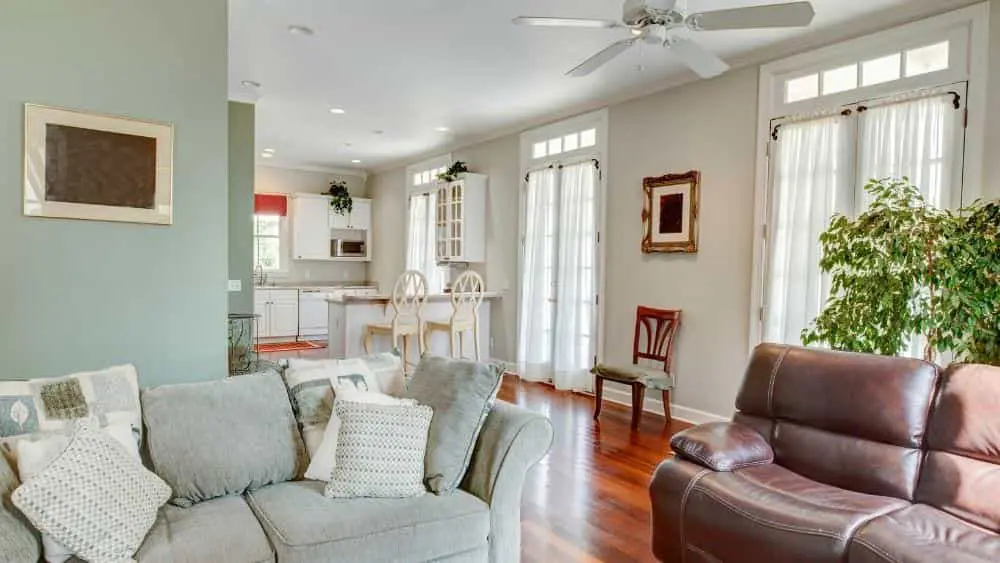
While there’s no question that most buyers today want an open floor plan, there are hints that indicate an emerging trend toward a little more definition in homes.
Consumer survey data by Better Homes & Gardens and Traditional Home, presented at the 2018 International Builders Show in Orlando in January, revealed a slight drop in the number of people who said they prefer a combined kitchen, family room and everyday eating space from 52 percent down to 46 percent.
While this doesn’t necessarily signal a shift away from an open floor plan, it’s something to keep an eye in future surveys, said Jill Waage, editor-in-chief of Traditional Home.
As with all survey data, accuracy depends on how well respondents understand the questions.
“When we asked buyers in 2017 if they wanted a great room versus a formal space, 75 percent of them said they wanted a great room,” said Mollie Carmichael, principal of Meyers Research, based in Costa Mesa. “But when you give them a choice between a great room, a traditional floor plan or a great room with one formal space such as a dining room or a living room, the numbers change. In that case, we found that 40 percent want a great room, 44 percent want a great room and one formal space and 16 percent want a traditional floor plan.”
The Uber Eats Effect
While those numbers indicate consumer preferences for an open kitchen, Carmichael is keeping her eye on the food delivery phenomenon that seems to be taking over the country.
“When we ask people how often they cook dinner versus eat out or order in, we find the average number of times people cook dinner is only three times per week,” said Carmichael. “The more delivery becomes easy and cost effective, the more people will choose that option.”
The concept of a big open kitchen as entertaining space, where guests gather while the hosts cook for them, could be less appealing if people have food delivered.
“I can see the kitchen going off to a galley space, especially if that means you can design a bigger, better entertaining space with a serving center,” said Carmichael. “There’s no need to devote as much space for prepping and cooking.”
Buyer preference surveys, floor plan designs and virtual reality tours will take time before builders start to build galley kitchens. It remains to be seen if that idea takes off, said Carmichael.
Factors That Influence Floor Plan Preferences
From townhouses to single-family homes to $1 million custom homes, everyone seems to want open floor plans, said Donna Southwick, director of architecture at Edward Andrews Homes in Atlanta.
“Our best-selling single-family home floor plans for the past decade or so have an open kitchen, breakfast area and family room,” said Southwick. “Our new ranch-style plans for active adults have an even more open floor plan, but they also have a flex room at the front of the house that can be used as a dining room, an office or even a bedroom.”
However, Southwick said that design innovations tend to start in the Northeast or on the West Coast before spreading to other markets. Buyer preferences also vary depending on how large a home they are buying and even demographics.
“In my research of Millennials, it’s amazingly close to 50/50 of young people that want a formal dining room blocked off versus those that want the open floor plan,” said Ali Wolf, manger of housing economics for Meyers Research.
Older buyers want a big open kitchen mostly for looks rather than because they cook a lot, said Carmichael.
“Youngers buyers are more likely to want formal space than older buyers, because they want a clean and organized space to entertain their adult friends versus the space where their kids keep all their toys and other stuff,” she said.
Buyers of smaller condos, townhouses and single-family homes are more likely to want an open floor plan to maximize their square footage, said Mei-Mei Venners, director of sales for the Westlight, a luxury condo building in Washington, D.C.
“Our larger units appeal to an affluent buyer who is downsizing from a larger home,” said Venners. “They want some openness, but they also want some defined space rather than just an open loft without any definition.”
Most of the condos at the Westlight have floor plans with an open kitchen and casual area, as well as a partially closed-off room that can be used as a dining room or living room. The building even has a couple of floor plans with closed kitchens for homeowners who prefer to hire caterers when entertaining.
“The majority of condo buyers don’t want to walk directly into the kitchen,” said Venners. “So there has to be some definition of space to avoid that. Sometimes a two-sided fireplace works well so you can get light through the fireplace, along with separation.”
Buyers who like open floor plans, but just want a little privacy for their kitchen sink may be interested in a higher center island or a two-level island, but Southwick said that most buyers want a big, one-level island they can use for casual dining and as a buffet when entertaining.
“Buyers used to be split 50/50 about raised versus flat islands, but now the trend is completely for flat islands,” said Carmichael.
The New American Home, a show house built in Orlando for the 2018 International Builders Show, has an open floor plan with open site lines throughout most of the main level. However, a second island between the center island kitchen and the open dining and living area separates the spaces and provides a little distance between the cooking appliances and the dining table.
While Southwick said she doesn’t see any indication that buyers in the Atlanta region want to close their floor plan, she said flexible floor plans are essential.
“People want rooms that they can use however they want and to be able to personalize their homes,” she said.
For some buyers, that could mean adding a two-sided fireplace or a partial wall to define their space, while others use rugs and furniture to create the illusion of different rooms. For others, a formal dining room is a desirable alternative entertaining space.

Michele Lerner is an award-winning freelance writer, editor and author who has been writing about real estate, personal finance and business topics for more than two decades.
 Trending: Glass Walls That Disappear
Trending: Glass Walls That Disappear